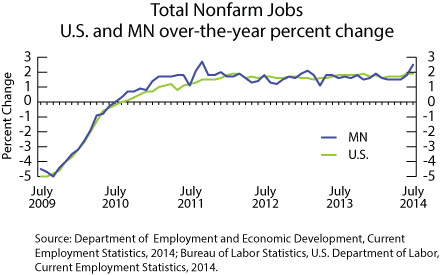by Nick Dobbins
August 2014
Monthly analysis is based on unadjusted employment data.
Employment dropped sharply in June as the metro shed 16,062 jobs (0.9 percent) over the month. The decline was likely the product of schools beginning their summer break. Government employment saw the biggest swing, off 17,940 (7.3 percent). The Local Government Educational Services sector led the way with a loss of 19,565 jobs (22.3 percent). Employment dropped in private education as well, as the Educational and Health Services supersector lost 4,553 jobs (1.5 percent) with the Educational Services component accounting for 2,656 of that decline (a 6.5 percent drop). Supersectors with significant job growth included Mining, Logging, and Construction (up 1,085 or 1.6 percent) and Financial Activities (up 1,677, 1.2 percent). Employment in the metro is up 46,339 (2.6 percent) for the year, with Government showing the biggest changes, up 17,348 (8.3 percent) over July 2013. The growth in Government employment is split between education and non-education, with Local Government Educational Services up 10,963 (19.2 percent) and all other Local Government up 6,555 (9.4 percent).
Employment shrank in July: The metro lost 780 jobs (0.6 percent) from June estimates in part from a sharp decline in Government Employment (down 2,269, 8.9 percent), specifically in Local Government, which lost 1,941 jobs (11.4 percent). This suggests that much of the job losses were in Local Government Educational Services, although data for metros besides Minneapolis-St. Paul is not granular enough to know for certain. The biggest monthly gainers: Mining, Logging, and Construction added 625 jobs (6.8 percent). For the year, employment in the Duluth metro is up 1,145 (0.9 percent), led by gains in Mining, Logging, and Construction (up 919 or 10.3 percent) with Trade, Transportation, and Utilities also showing solid growth (up 385, 1.6 percent).
Employment dipped slightly in July, down 321 (0.3 percent). Gains in Manufacturing (up 321, 3.1 percent), Leisure and Hospitality (up 138, 1.4 percent) and Educational and Health Services (122, 0.3 percent) were erased by losses in Trade, Transportation, and Utilities (down 175, 1 percent) and Government (down 744, 6.5 percent). Government declines were concentrated in Local Government, which lost 656 jobs (7.3 percent). For the year the Rochester metro added 1,054 jobs (1 percent), with gains in every supersector save Mining, Logging, and Construction (down 172, or 4.4 percent) and Financial Activities (down 40, 1.5 percent). The largest numerical gains came in Trade, Transportation, and Utilities, which added 420 jobs (2.6 percent) on the strength of a gain of 362 (3.1 percent) in Retail Trade.
The St. Cloud MSA lost 1,210 jobs (1.1 percent) in July as an increase of 437 (2 percent) among goods producers couldn't overcome the loss of 1,647 (2 percent) in service providers. Declines were driven by Local Government employment, which lost 1,088 jobs (12.1 percent), likely caused by drops in education, and contributed to the overall loss of 1,318 (8.9 percent) in all Government employment. The largest gains in the metro came in Mining, Logging, and Construction, which added 361 jobs (5.8 percent) in July. For the year, St. Cloud employment grew by 2,894 (2.8 percent).
Employment dropped in July, losing 1,714 jobs (3.1 percent) for an estimated total of 53,804. Both Private and Government employers shed employment (496 or 1.1 percent and 1,218 or 13.2 percent, respectively). Private goods producers grew slightly, adding 47 jobs (0.5 percent). For the year, the metro added 1,236 jobs (2.4 percent).
Employment dropped by 1,846 (1.3 percent) in July. Supersectors with significant movement included Government (down 2,255 or 13 percent) and Trade, Transportation, and Utilities, which gained 469 jobs (1.6 percent) on the strength of Retail Trade's 421 new jobs, a 2.8 percent increase. Employment in the metro is up 6,039 (4.6 percent) for the year. Two supersectors stand out by virtue of both their numerical and proportional employment gains: Mining, Logging, and Construction added 1,499 jobs (16.4 percent) and Professional and Business Services added 1,598 (10.3 percent).
The MSA shed 1,777 jobs (3.2 percent) last month, with the lion's share coming from Local Government (down 1,756 or 30.1 percent), leading to a 12.8 percent loss in the Government supersector. On the year, the area has added 466 jobs (0.9 percent). Gains in Mining, Logging and Construction (up 213, 6.1 percent), Trade, Transportation, and Utilities (252, 2.1 percent), and Educational and Health Services (203, 2.1 percent) overcame losses in Professional and Business Services (down 126, 4.3 percent) and Leisure and Hospitality (191, 3.3 percent).
